Light is tricky stuff, and it took scientists hundreds of years to puzzle out what this stuff is. But they poked and prodded at it with many clever experiments to try to measure its speed, motion and interaction with the rest of the Universe. For example, the Fizeau Experiment, which ran light through moving water to see if that caused a difference.
Continue reading “Astronomy Cast Ep. 369: The Fizeau Experiment”
How Far Back Are We Looking in Time?
When we look out into space, we’re also looking back into time. Just how far back can we see?
The Universe is a magic time window, allowing us to peer into the past. The further out we look, the further back in time we see. Despite our brains telling us things we see happen at the instant we view them, light moves at a mere 300,000 kilometers per second, which makes for a really weird time delay at great distances.
Let’s say that you’re talking with a friend who’s about a meter away. The light from your friend’s face took about 3.336 nanoseconds to reach you. You’re always seeing your loved ones 3.336 nanoseconds into the past. When you look around you, you’re not seeing the world as it is, you’re seeing the world as it was, a fraction of a second ago. And the further things are, the further back in time you’re looking.
The distance to the Moon is, on average, about 384,000 km. Light takes about 1.28 seconds to get from the Moon to the Earth. If there was a large explosion on the Moon of a secret Nazi base, you wouldn’t see it for just over a second. Even trying to communicate with someone on the Moon would be frustrating as you’d experience a delay each time you talked.
Let’s go with some larger examples. Our Sun is 8 minutes and 20 seconds away at the speed of light. You’re not seeing the Sun as it is, but how it looked more than 8 minutes ago.
On average, Mars is about 14 light minutes away from Earth. When we were watching live coverage of NASA’s Curiosity Rover landing on Mars, it wasn’t live. Curiosity landed minutes earlier, and we had to wait for the radio signals to reach us, since they travel at the speed of light.
When NASA’s New Horizons spacecraft reaches Pluto next year, it’ll be 4.6 light hours away. If we had a telescope strong enough to watch the close encounter, we’d be looking at events that happened 4.6 hours ago.
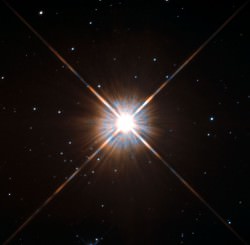
The closest star, Proxima Centauri, is more than 4.2 light-years away. This means that the Proxima Centurans don’t know who won the last US Election, or that there are going to be new Star Wars movies. They will, however, as of when this video was produced, be watching Toronto make some questionable life choices regarding its mayoral election.
The Eagle Nebula with the famous Pillars of Creation, is 7,000 light-years away. Astronomers believe that a supernova has already gone off in this region, blasting them away. Take a picture with a telescope and you’ll see them, but mostly likely they’ve been gone for thousands of years.
The core of our own Milky Way galaxy is about 25,000 light-years away. When you look at these beautiful pictures of the core of the Milky Way, you’re seeing light that may well have left before humans first settled in North America.
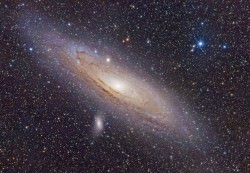
And don’t get me started on Andromeda. That galaxy is more than 2.5 million light-years away. That light left Andromeda before we had Homo Erectus on Earth. There are galaxies out there, where aliens with powerful enough telescopes could be watching dinosaurs roaming the Earth, right now.
Here’s where it gets even more interesting. Some of the brightest objects in the sky are quasars, actively feeding supermassive black holes at the cores of galaxies. The closest is 2.5 billion light years away, but there are many much further out. Earth formed only 4.5 billion years ago, so we can see quasars shining where the light had left before the Earth even formed.
The Cosmic Microwave Background Radiation, the very edge of the observable Universe is about 13.8 billion light-years away. This light left the Universe when it was only a few hundred thousand years old, and only now has finally reached us. What’s even stranger, the place that emitted that radiation is now 46 billion light-years away from us.
So crack out your sonic screwdrivers and enjoy your time machine, Whovians. Your ability to look out into space and peer into the past. Without a finite speed of light, we wouldn’t know as much about the Universe we live in and where we came from. What moment in history do you wish you could watch? Express your answer in the form of a distance in light-years.
Astronomy Cast Ep. 368: Searching for the Aether Wind: the Michelson–Morley Experiment
Waves move through a medium, like water or air. So it seemed logical to search for a medium that light waves move through. The Michelson-Morley Experiment attempted to search for this medium, known as the “luminiferous aether”. The experiment gave a negative result, and helped set the stage for the theory of General Relativity.
Continue reading “Astronomy Cast Ep. 368: Searching for the Aether Wind: the Michelson–Morley Experiment”
What Will We Never See?
Thanks to our powerful telescopes, there are so many places in the Universe we can see. But there are places hidden from us, and places that we’ll never be able to see.
We’re really lucky to live in our Universe with our particular laws of physics. At least, that’s what we keep telling ourselves. The laws of physics can be cruel and unforgiving, and should you try and cross them, they will crush you like a bug.
Here at Universe Today, we embrace our Physics overlords and prefer to focus on the positive, the fact that light travels at the speed of light is really helpful. This allows us to look backwards in time as we look further out. Billions of light-years away, we can see what the Universe looked like billions of years ago. Physics is good. Physics knows what’s best. Thanks physics. And where the hand of physics gives, it can also take away.
There are some parts of the Universe that we’ll never, ever be able to see. No matter what we do. They’ll always remain just out of reach. No matter how much we plead, in some sort of Kafka-esque nightmare, these rules do not appear to have conscience or room for appeal.
As we look outward in the cosmos, we look backwards in time and at the very edge of our vision is the Cosmic Microwave Background Radiation. The point after the Big Bang where everything had cooled down enough so it was no longer opaque. Light could finally escape and travel through a transparent Universe. This happened about 300,000 years after the Big Bang. What happened before that is a mystery. We can calculate what the Universe was like, but we can’t actually look at it. Possibly, we just don’t have the right clearance levels.
On the other end of the timeline, in the distant distant future. Assuming humans, or our Terry Gilliam inspired robot bodies are still around to observe the Universe, there will be a lot less to see. Distance is also out to rain on our sightseeing safari. The expansion of the Universe is accelerating, and galaxies are speeding away from each other faster and faster. Eventually, they’ll be moving away from us faster than the speed of light.

When that happens, we’ll see the last few photons from those distant galaxies, redshifted into oblivion. And then, we won’t see any galaxies at all. Their light will never reach us and our skies will be eerily empty. Just don’t let physics hear a sad tone in your voice, we don’t want to spend another night in the “joy re-education camps”
Currently, we can see a sphere of the Universe that measures 92 billion light-years across. Outside that sphere is more Universe, a hidden, censored Universe. Universe that we can’t see because the light hasn’t reached us yet. Fortunately, every year that goes by, a little less Universe is redacted from the record, and the sphere we can observe gets bigger by one light-year. We can see a little more in all directions.
Finally, let’s consider what’s inside the event horizon of a black hole. A place that you can’t look at, because the gravity is so strong that light itself can never escape it. So by definition, you can’t see what absorbs all its own light. Astronomers don’t know if black holes crunch down to a physical sphere and stop shrinking, or continue shrinking forever, getting smaller and smaller into infinity. Clearly, we can’t look there because we shouldn’t be looking there. They’re terrible places. The possibility of shrinking forever gives me the heebies.
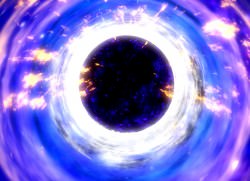
And so, good news! The chocolate ration has been increased from 40 grams to 25 grams, and our physics overlords are good, can only do good, and always know what’s best for us. In fact, so good that gravity might actually provide us with a tool to “see” these hidden places, but only because “they” want us to.
When black holes form, or massive objects smash into each other, or there are “Big Bangs”, these generate distortions in spacetime called gravitational waves. Like gravity itself, these propagate across the Universe and could be detected.It’s possible we could use gravitational waves to “see” beyond the event horizon of a black hole, or past the Cosmic Microwave Background Radiation.
The problem is that gravitational waves are so faint, we haven’t even detected a single one yet. But that’s probably just a technology problem. In the end, we need a more sensitive observatory. We’ll get there. Alternately we could apply to the laws of physics board of appeals and fill in one of their 2500 page application forms in triplicate and see if we can be granted a rules exception, and maybe just get a tiny little peek behind that veil.
We live an amazing Universe, most of which we’ll never be able to see. But that’s okay, there’s enough we can see to keep us busy until infinity. What law of physics would you like to be granted a special exception to ignore. Tell us in the comments below.
Why Is Space Black?
Since there are stars and galaxies in all directions, why is space black? Shouldn’t there be a star in every direction we look?
Imagine you’re in space. Just the floating part, not the peeing into a vacuum hose or eating that funky “ice cream” from foil bags part. If you looked at the Sun, it would be bright and your retinas would crisp up. The rest of the sky would be a soothing black, decorated with tiny little less burny points of light.
If you’ve done your homework, you know that space is huge. It even be infinite, which is much bigger than huge. If it is infinite you can imagine looking out into space in any direction and there being a star. Stars would litter everything. Dumb stars everywhere wrecking the view. It’s stars all the way down, people.
So, shouldn’t the entire sky be as bright as a star, since there’s a star in every possible minute direction you could ever look in? If you’ve ever asked yourself this question, you probably won’t be surprised to know you’re not the first. Also, at this point you can tell people you were wondering about it and they’ll never know you just watched it here and then you can sound wicked smart and impress all those dudes.
This question was famously asked by the German astronomer Heinrich Wilhelm Olbers who described it in 1823. We now call this Olbers’ Paradox after him. Here let me give you a little coaching, you’ll start your conversation at the party with “So, the other day, I was contemplating Olbers’ Paradox… Oh what’s that? You don’t know what it is… oh that’s so sweet!”. The paradox goes like this: if the Universe is infinite, static and has existed forever, then everywhere you look should eventually hit a star.
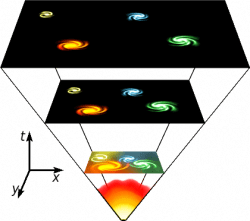
Our experiences tell us this isn’t the case. So by proposing this paradox, Olbers knew the Universe couldn’t be infinite, static and timeless. It could be a couple of these, but not all three. In the 1920s, debonair man about town, Edwin Hubble discovered that the Universe isn’t static. In fact, galaxies are speeding away from us in all directions like we have the cooties.
This led to the theory of the Big Bang, that the Universe was once gathered into a single point in time and space, and then, expanded rapidly. Our Universe has proven to not be static or timeless. And so, PARADOX SOLVED!
Here’s the short version. We don’t see stars in every direction because many of the stars haven’t been around long enough for their light to get to us. Which I hope tickles your brain in the way it does mine. Not only do we have this incomprehensibly massive size of our Universe, but the scale of time we’re talking about when we do these thought experiments is absolutely boggling. So, PARADOX SOLVED!
Well, not exactly. Shortly after the Big Bang, the entire Universe was hot and dense, like the core of a star. A few hundred thousand years after the Big Bang, when the first light was able to leap out into space, everything, in every direction was as bright as the surface of a star.
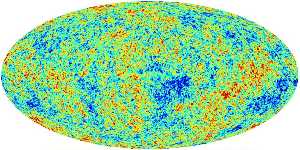
So, in all directions, we should still be seeing the brightness of a star.. and yet we don’t. As the Universe expanded, the wavelengths of that initial visible light were stretched out and out and dragged to the wide end of the electromagnetic spectrum until they became microwaves. This is Cosmic Microwave Background Radiation, and you guessed it, we can detect it in every direction we can look in.
So Olbers’ instinct was right. If you look in every direction, you’re seeing a spot as bright as a star, it’s just that the expansion of the Universe stretched out the wavelengths so that the light is invisible to our eyes. But if you could see the Universe with microwave detecting eyes, you’d see this: brightness in every direction.
Did you come up with Olbers’ Paradox too? What other paradoxes have puzzled you?
How are Energy and Matter the Same?
As Einstein showed us, light and matter and just aspects of the same thing. Matter is just frozen light. And light is matter on the move. How does one become the other?
Albert Einstein’s most famous equation says that energy and matter are two sides of the same coin.
But what does that really mean? And how are equations famous? I like to believe equations can be famous in the way a work of art, or a philosophy can be famous. People can have awareness of the thing, and yet never have interacted with it. They can understand that it is important, and yet not understand why it’s so significant. Which is a little too bad, as this is really a lovely mind bending idea.
The origin of E=mc2 lies in special relativity. Light has the same speed no matter what frame of reference you are in. No matter where you are, or how fast you’re going. If you were standing still at the side of the road, and observed a car traveling at ¾ light speed, you would see the light from their headlights traveling away from them at ¼ the speed of light.
But the driver of the car would still see that the light moving ahead of them at the speed of light. This is only possible if their time appears to slow down relative to you, and you and the people in the car can no longer agree on how long a second would take to pass.

So the light appears to be moving away from them more slowly, but as they experience things more slowly it all evens out. This also affects their apparent mass. If they step on the gas, they will speed up more slowly than you would expect. It’s as if the car has more mass than you expect. So relativity requires that the faster an object moves, the more mass it appears to have. This means that somehow part of the energy of the car’s motion appears to transform into mass. Hence the origin of Einstein’s equation. How does that happen? We don’t really know. We only know that it does.
The same effect occurs with quantum particles, and not just with light. A neutron, for example, can decay into a proton, electron and anti-neutrino. The mass of these three particles is less than the mass of a neutron, so they each get some energy as well. So energy and matter are really the same thing. Completely interchangeable. And finally, Although energy and mass are related through special relativity, mass and space are related through general relativity. You can define any mass by a distance known as its Schwarzschild radius, which is the radius of a black hole of that mass. So in a way, energy, matter, space and time are all aspects of the same thing.
What do you think? Like E=mc2, what’s the most famous idea you can think of in physics?
And if you like what you see, come check out our Patreon page and find out how you can get these videos early while helping us bring you more great content!
Are All the Stars Really Dead?
Have you ever heard that meme, “When looking at stars, you’re actually looking into the past. Many of the stars we see at night have already died.” Is this true?
While you’re flipping through your Pinterest collection of cat-based inspirational posters, you might come across the saying, “When looking at stars, you’re actually looking into the past. Many of the stars we see at night have already died. Like your dreams.”
Aww, that’s mean and sad. But is it true, Squidward? Are all these beautiful stars in our night sky long gone? Like our dreams?
Light travels at about 300,000 km/s, which is incredibly fast. Stars are so far away, even light from the closest stars will take years to get to us travelling at that speed. Most of the stars we see with the naked eye are actually pretty close. The brightest in the night sky is Sirius in the constellation Canis Major. It’s only about 8.6 light years away.
Which means if you crashed a whole bunch of spaceships into it tomorrow, we here on Earth wouldn’t see it happen for almost a decade. Long after people had stopped wondering where you’d picked up all those spaceships, and why had you decided to crash them into a star instead of trading for gold pressed latinum, the spice Melange, or magical space cheese.
One of the most distant naked eye stars is Deneb in the constellation Cygnus, which is almost 3,000 light years away. The light we’re seeing from Deneb started its journey towards us when ancient Rome was just a few hamlets and not even on the map for real estate speculators.
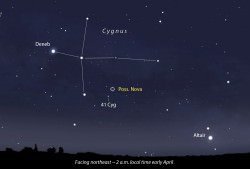
This might seem like a really long time for those of us without immortal robot bodies, but a few thousand years is negligible to the age of a typical star, which is on the order of billions of years. So, Deneb, barring removal for an interstellar bypass, is probably still there.
There are a few stars that could possibly explode in the near future, such as the red giant star Betelgeuse in the constellation of Orion.
It’s about 650 light years away, if it had exploded a couple centuries ago, we still wouldn’t know. There are a few galaxies that can be seen with the naked eye, such as Andromeda, which is about 2.5 million light years away. Given that Andromeda has somewhere between 200 and 400 billion stars, it is almost certain that some of them have exploded in the last 2 and a half million years. But the vast majority of them have are still there, twinkling away.
So it is possible that you could look up in the night sky and see a “dead” star, but almost all of the stars you see are perfectly active main-sequence stars, and will be for quite some time. Telescopes allow us to see much further out into space, billions of light years away. Given that a star like our Sun has a lifetime of about 10 billion years, many stars in most of the distant galaxies we observe died long ago.

But don’t be sad, we’re not running out of stars. Because of this huge passage of time, it means many new stars have been born, and we just aren’t able to see them yet. There are some stars even in the most distant galaxies that are still around.
Smaller stars live longer than larger stars, and red dwarf stars can live for trillions of years. So when you look at the Hubble Ultra Deep Field, the most distant galaxies are around 13 billion years old, and the smaller stars in those galaxies are still shining. So don’t worry. Those stars are still there, and so are your dreams.
What do you think? If you go get a closeup look and see which stars were still around, where would you go look first? Tell us in the comments below.
And if you like what you see, come check out our Patreon page and find out how you can get these videos early while helping us bring you more great content!
Does Light Experience Time?
Have you ever noticed that time flies when you’re having fun? Well, not for light. In fact, photons don’t experience any time at all. Here’s a mind-bending concept that should shatter your brain into pieces.
As you might know, I co-host Astronomy Cast, and get to pick the brain of the brilliant astrophysicist Dr. Pamela Gay every week about whatever crazy thing I think of in the shower. We were talking about photons one week and she dropped a bombshell on my brain. Photons do not experience time. [SNARK: Are you worried they might get bored?]
Just think about that idea. From the perspective of a photon, there is no such thing as time. It’s emitted, and might exist for hundreds of trillions of years, but for the photon, there’s zero time elapsed between when it’s emitted and when it’s absorbed again. It doesn’t experience distance either. [SNARK: Clearly, it didn’t need to borrow my copy of GQ for the trip.]
Since photons can’t think, we don’t have to worry too much about their existential horror of experiencing neither time nor distance, but it tells us so much about how they’re linked together. Through his Theory of Relativity, Einstein helped us understand how time and distance are connected.
Let’s do a quick review. If we want to travel to some distant point in space, and we travel faster and faster, approaching the speed of light our clocks slow down relative to an observer back on Earth. And yet, we reach our destination more quickly than we would expect. Sure, our mass goes up and there are enormous amounts of energy required, but for this example, we’ll just ignore all that.
If you could travel at a constant acceleration of 1 g, you could cross billions of light years in a single human generation. Of course, your friends back home would have experienced billions of years in your absence, but much like the mass increase and energy required, we won’t worry about them.
The closer you get to light speed, the less time you experience and the shorter a distance you experience. You may recall that these numbers begin to approach zero. According to relativity, mass can never move through the Universe at light speed. Mass will increase to infinity, and the amount of energy required to move it any faster will also be infinite. But for light itself, which is already moving at light speed… You guessed it, the photons reach zero distance and zero time.
Photons can take hundreds of thousands of years to travel from the core of the Sun until they reach the surface and fly off into space. And yet, that final journey, that could take it billions of light years across space, was no different from jumping from atom to atom.
There, now these ideas can haunt your thoughts as they do mine. You’re welcome. What do you think? What’s your favorite mind bending relativity side effect? Tell us in the comments below.
Can Light Orbit A Black Hole?
Since black holes are the most powerful gravitational spots in the entire Universe, can they distort light so much that it actually goes into orbit? And what would it look like if you could survive and follow light in this trip around a black hole?
I had this great question in from a viewer. Is it possible for light to orbit a black hole?
Consider this thought experiment, first explained by Newton. Imagine you had cannon that could shoot a cannonball far away. The ball would fly downrange and then crash into the dirt. If you shot the cannonball harder it would fly further before slamming into the ground. And if you could shoot the cannonball hard enough and ignore air resistance – it would travel all the way around the Earth. The cannonball would be in orbit. It’s falling towards the Earth, but the curvature of the Earth means that it’s constantly falling just over the horizon.
This works not only with cannonballs, astronauts and satellites, but with light too. This was one of the big discoveries that Einstein made about the nature of gravity. Gravity isn’t an attractive force between masses, it’s actually a distortion of spacetime. When light falls into the gravity well of a massive object, it bends to follow the curvature of spacetime.
Distant galaxies, the Sun, and even our own Earth will cause light to be deflected from its path by their distortion of spacetime. But it’s the incredible gravity of a black hole that can tie spacetime in knots. And yes, there is a region around a black hole where even photons are forced to travel in an orbit. In fact, this region is known as the “photon sphere”.
From far enough away, black holes act like any massive object. If you replaced the Sun with a black hole of the same mass, our Earth would continue to orbit in exactly the same way. But as you get closer and closer to the black hole, the orbiting object needs to go faster and faster as it whips around the massive object. The photon sphere is the final stable orbit you can have around a black hole. And only light, moving at, well, light speed, can actually exist at this altitude.
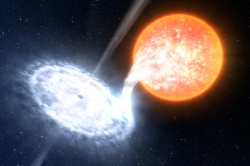
Imagine you could exist right at the photon sphere of a black hole. Which you can’t, so don’t try. You could point your flashlight in one direction, and see the light behind you, after it had fully orbited the black hole. You would also be bathed in the radiation of all the photons captured in this region. The visible light might be pretty, but the x-ray and gamma radiation would cook you like an oven.
Below the photon sphere you would see only darkness. Down there is the event horizon, light’s point of no return. And up above you’d see the Universe distorted by the massive gravity of the black hole. You’d see the entire sky in your view, even stars that would be normally obscured by the black hole, as they wrap around its gravity. It would be an awesome and deadly place to be, but it’d sure beat falling down below the event horizon.
If you could get down into the photon sphere, what kind of experiments would you want to do? Tell us in the comments below.
Astronomy Cast Ep. 335: Photoelectric Effect
Pop quiz. How did Einstein win his Nobel prize? Was it for relativity? Nope, Einstein won the Nobel Prize in 1921 for the discovery of the photoelectric effect; how electrons are emitted from atoms when they absorb photons of light. But what is it? Let’s find out.
Continue reading “Astronomy Cast Ep. 335: Photoelectric Effect”







